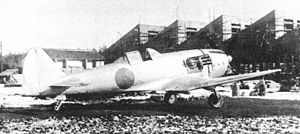Nakajima Ki-87
| Ki-87 | |
|---|---|
 | |
| General information | |
| Type | High-altitude fighter-interceptor |
| Manufacturer | Nakajima Aircraft Company |
| Status | Prototype |
| Primary user | Imperial Japanese Army Air Service |
| Number built | 1 |
| History | |
| First flight | April 1945 |
The Nakajima Ki-87 was a Japanese prototype high-altitude fighter-interceptor of World War II. It was a single seat, exhaust-driven turbo-supercharged engined, low-wing monoplane with a conventional undercarriage.
Design and development
[edit]The Ki-87 was developed in response to American B-29 Superfortress raids on the Home Islands. It followed up on earlier research by Nakajima and the Technical Division of Imperial Army Headquarters into boosting a large radial engine with an exhaust-driven turbo-supercharger, which had begun in 1942, well before the B-29 raids began.[1] The efforts of the Technical Division of Imperial Army Headquarters eventually culminated into the Tachikawa Ki-94-I, while the Ki-87 was developed as a fall-back project, using less stringent requirements.[2][3] Nakajima started in July 1943 with the construction of three prototypes, to be completed between November 1944 and January 1945, and seven pre-production aircraft, to be delivered by April 1945.[3] The Technical Division of Imperial Army Headquarters made itself felt during the development of the Ki-87 prototype when they insisted upon placing the turbo-supercharger in the rear-fuselage, and from the sixth prototype the Nakajima fighter was to have that arrangement.[4][5] The Ki-87 had a rearward folding undercarriage to accommodate the storage of ammunition for the cannons, which were mounted in the wing.[1][6]
Construction was delayed due to problems with the electrical undercarriage and the turbo-supercharger, and the first prototype was not completed until February 1945; it first flew in April, but only five test flights were completed, all with the undercarriage in the extended position.[6][7]
A further variant, the Ki-87-II, powered by a 3,000 hp (2,200 kW) Nakajima Ha-217 (Ha-46) engine and with the turbo-supercharger in the same position as the P-47 Thunderbolt, never went further than the drawing board.
Operational history
[edit]Production of 500 aircraft was planned, but the war ended before any more than the single prototype were built.
Aircraft markings
[edit]The sole completed prototype was in natural metal finish; some paintings show a black anti-glare area in front of the cockpit, but this is not seen on any of the known photographs of the plane.[1][8][9] However, James P. Gallagher took a photo of the Ki-87 at the abandoned Japanese Army fighter base at Chofu after Japan's surrender. The photo clearly shows a black anti-glare area from the cockpit forward to the tip of the nose.[10]
Specifications (Ki-87 prototype)
[edit]
Data from Japanese Aircraft of the Pacific War;[6] Japanese Army Fighters, Part 2;[7] Famous Aircraft of the World, first series, no.76: Japanese Army Experimental Fighters (1)[11]
General characteristics
- Crew: 1
- Length: 11.82 m (38 ft 9 in)
- Wingspan: 13.423 m (44 ft 0 in)
- Height: 4.503 m (14 ft 9 in)
- Wing area: 26 m2 (280 sq ft)
- Empty weight: 4,387 kg (9,672 lb)
- Gross weight: 5,632 kg (12,416 lb)
- Max takeoff weight: 6,100 kg (13,448 lb)
- Powerplant: 1 × Nakajima Ha219 Ru (Ha-44 Model 11) 18-cylinder air-cooled radial piston engine, 1,800 kW (2,400 hp) for take-off
- 1,600 kW (2,200 hp) at 1,500 m (4,900 ft)
- 1,530 kW (2,050 hp) at 6,000 m (20,000 ft)
- 1,380 kW (1,850 hp) at 10,500 m (34,400 ft)
- Propellers: 4-bladed constant-speed metal propeller
Performance
- Maximum speed: 706 km/h (439 mph, 381 kn) at 11,000 m (36,000 ft)
- Endurance: 2 hours
- Service ceiling: 12,855 m (42,175 ft)
- Time to altitude: 10,000 m (33,000 ft) in 14 minutes 12 seconds
- Wing loading: 216.6 kg/m2 (44.4 lb/sq ft)
- Power/mass: 0.3161 kW/kg (0.1923 hp/lb)
Armament
- Guns: 2 × 30 mm (1.18 in) Ho-155 cannon in the outer wing panels and 2 × 20 mm (0.79 in) synchronized Ho-5 cannon in the wing roots
- Bombs: 1 × 250 kg (550 lb) bomb under fuselage
See also
[edit]Aircraft of comparable role, configuration, and era
- Blohm & Voss BV 155
- Curtiss XF14C
- Fisher P-75 Eagle
- Focke-Wulf Ta 152H
- Republic P-47N Thunderbolt
- Republic XP-72
- Tachikawa Ki-94-II
References
[edit]- Notes
- ^ a b c Green 1961, p. 90.
- ^ Francillon 1979, p. 238 and 265.
- ^ a b Green & Swanborough 1976, p. 62.
- ^ Green & Swanborough 1976, p. 63.
- ^ Francillon 1979, p. 239.
- ^ a b c Francillon 1979, p. 240.
- ^ a b Green & Swanborough 1976, p. 64.
- ^ FAOW 1976, pp. 59–61 and front cover.
- ^ Green & Swanborough 1976, pp. 62–64.
- ^ James P. Gallagher, With the Fifth Army Air Force: Photos From the Pacific Theater (2001; Johns Hopkins University Press, Baltimore)
- ^ FAOW 1976, p. 67.
- Bibliography
- Francillon, René J. (1979). Japanese aircraft of the Pacific War. London: Putnam. ISBN 0-370-30251-6. OCLC 6124909. (new edition 1987 by Putnam Aeronautical Books, ISBN 0-85177-801-1.)
- Green, William (1961). War Planes of the Second World War, Volume Three: Fighters. Macdonald & Co. ISBN 0-356-01447-9. OCLC 655407936.
- Green, William; Swanborough, Gordon (1976). JWW2 Aircraft Fact Files: Japanese Army Fighters, Part 1. London: Macdonald and Jane's. ISBN 0-356-08224-5. OCLC 820486093.
- Famous Aircraft of the World, first series, no.76: Japanese Army Experimental Fighters (1). Japan: Bunrin-Do Co. Ltd. August 1976.
